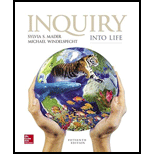
To determine:
The mechanism of meiosis that results in haploid gametes production.
Introduction:
Meiosis is a type of cell division that causes the formation of gametes. In this process, the number of chromosomes is decreased into half of the initial chromosome number, which makes up the haploid gametes.
Explanation of Solution
An animal is multicellular organism and contains a diploid number of chromosomes, which is each parent cell contains a diploid number of chromosomes. In order to produce haploid gametes, the division of cell should be in such a manner that half of the number of chromosome or each copy of a chromosome is present in daughter cell.
The meiosis is divided in two phases, meiosis I and meiosis II. The Meiosis I is the reductional division and in the metaphase I of meiosis I, the sister chromatids containing identical genes are separated, which result in formation of the haploid cells.
So, the parent cell which contains a diploid number of chromosomes undergoes meiosis that is reduction division. This results in gamete production which is haploid in nature containing half number of chromosomes to that of the parent chromosome.
Both male and female produce gametes haploid gametes. Only gamete production stage in animals is the phase which is haploid in nature. Now, when male and female gametes fuse they again produce a diploid zygote.
By reductional division durinng meiosis I, haploid gametes are produced containing half number of parent chromosome.
Want to see more full solutions like this?
Chapter 22 Solutions
INQUIRY INTO LIFE-W/ACCESS >CUSTOM<
 Human Anatomy & Physiology (11th Edition)BiologyISBN:9780134580999Author:Elaine N. Marieb, Katja N. HoehnPublisher:PEARSON
Human Anatomy & Physiology (11th Edition)BiologyISBN:9780134580999Author:Elaine N. Marieb, Katja N. HoehnPublisher:PEARSON Biology 2eBiologyISBN:9781947172517Author:Matthew Douglas, Jung Choi, Mary Ann ClarkPublisher:OpenStax
Biology 2eBiologyISBN:9781947172517Author:Matthew Douglas, Jung Choi, Mary Ann ClarkPublisher:OpenStax Anatomy & PhysiologyBiologyISBN:9781259398629Author:McKinley, Michael P., O'loughlin, Valerie Dean, Bidle, Theresa StouterPublisher:Mcgraw Hill Education,
Anatomy & PhysiologyBiologyISBN:9781259398629Author:McKinley, Michael P., O'loughlin, Valerie Dean, Bidle, Theresa StouterPublisher:Mcgraw Hill Education, Molecular Biology of the Cell (Sixth Edition)BiologyISBN:9780815344322Author:Bruce Alberts, Alexander D. Johnson, Julian Lewis, David Morgan, Martin Raff, Keith Roberts, Peter WalterPublisher:W. W. Norton & Company
Molecular Biology of the Cell (Sixth Edition)BiologyISBN:9780815344322Author:Bruce Alberts, Alexander D. Johnson, Julian Lewis, David Morgan, Martin Raff, Keith Roberts, Peter WalterPublisher:W. W. Norton & Company Laboratory Manual For Human Anatomy & PhysiologyBiologyISBN:9781260159363Author:Martin, Terry R., Prentice-craver, CynthiaPublisher:McGraw-Hill Publishing Co.
Laboratory Manual For Human Anatomy & PhysiologyBiologyISBN:9781260159363Author:Martin, Terry R., Prentice-craver, CynthiaPublisher:McGraw-Hill Publishing Co. Inquiry Into Life (16th Edition)BiologyISBN:9781260231700Author:Sylvia S. Mader, Michael WindelspechtPublisher:McGraw Hill Education
Inquiry Into Life (16th Edition)BiologyISBN:9781260231700Author:Sylvia S. Mader, Michael WindelspechtPublisher:McGraw Hill Education





